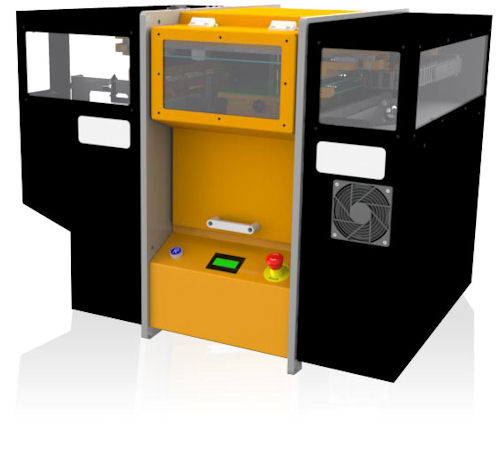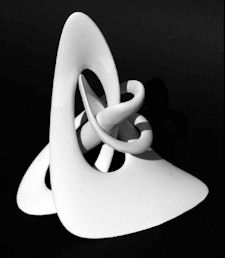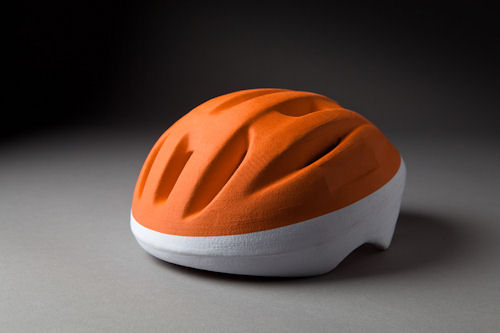Mcor Technologies Launches the Matrix 300+, 3 in a Series
3D printer that uses paper for build material is enhanced to reduce build time.
Latest News
October 17, 2012
By Anthony J. Lockwood
Mcor Technologies Ltd. (Dunleer, Ireland) has announced the Matrix 300+ 3D printer, an eco-friendly 3D printer that can make 3D objects appropriate for fit, form, and conceptual modeling using standard-sized paper such as A4 (210 x 297 mm; 8.3 x 11.7 in.) and a water-based adhesive.
 |
| The Matrix 300+ 3D printer from Mcor Technologies. |
The company, which describes itself as the “manufacturer of the only line of paper desktop 3D printers,” says that the ability of the Matrix 300+ to use paper as its modeling medium means that “material costs are a fraction of the cost of other technologies, making it affordable for all environments.”
 |
| Entwine_01 byProfessor Keith Brown, Professor of Sculpture & DigitalTechnologies, Manchester Metropolitan University. Image courtesy ofMcor Technologies. |
Mcor’s 3D printing process reportedly produces no fumes and it does not requires special ventilation or chemicals, enabling it to reside in office environments. Final parts are said to look and feel like plastic, making it suitable for conceptual and form/fit design purposes.
“The problem with 3D printing at the moment is the extremely high costs associated with running the machines,” wrote a company spokesperson in response to an e-mail inquiry from Desktop Engineering. “Mcor wants to give people the opportunity to build high-quality parts that don’t cost the Earth. So if you want to make low cost, eco-friendly and precise parts using a stable and ubiquitous material, ]the] Matrix 300+ is for you.”
Its new unit, says the company, has been re-designed to enable a faster turnaround on part production than its predecessor. The company has implemented what it calls a “Selectable Layer Thickness” (S.L.T.) technique that allows the printer to run in two different modes, draft or presentation. The main difference between these modes, says a Mcor spokesperson, is the draft mode has a larger layer thickness than the presentation mode. This enables the machine to run at twice the speed, giving users the advantage of getting their hands on a design sooner.
Additionally, Mcor has developed a new technique called V.V.D. (Variable Volume Deposition), which is said to enable the production of more complex parts than previously possible.
The Matrix 300+ comes with Mcor’s proprietary software, SliceIT. The software is said to accept solid models in STL and provide such functionality as 3D viewing, parts placement, orientation, and scaling.
Technical specifications of the Matrix 300+ include build sizes of approximately 10 x 6.66 x 5.9 in. (256 x 169 x 150 mm) with A4 paper and 9.39 x 6.89 x 5.9 in. (238.5 x 175 x 148.86 mm) with letter paper; layer thicknesses of 0.1 mm (0.004 in.) and 0.19 mm (0.007 in.); and 0.1 mm (0.004 in.) resolution.
 |
| Image courtesy of Mcor Technologies. |
The Matrix 300+ requires a Windows XP, Vista, or Windows 7 platform with 2GB memory, 100GB hard-drive, and two network cards (one for the printer). The company projects that the Matrix 300+ will be available globally in late 2012. Pricing has not yet been determined, but the company estimates that the Matrix 300+ will cost less than $15,000 in the US. For more information, visit Mcor Technologies.
Check out the Mcor part image gallery.
Read how Innermost Secrets creates a 3D print from baby scans.
Visit the Mcor Technologies blog.
Read John Newman’s report on the Matrix 300+ in DE’s Rapid Ready Technology blog.
See why DE’s editors selected the Matrix 300+ from Mcor Technologies as their Pick of the Week.
Sources: Press materials received from the company and additional information gleaned from the company’s website.
Subscribe to our FREE magazine, FREE email newsletters or both!
Latest News
About the Author
Anthony J. Lockwood is Digital Engineering’s founding editor. He is now retired. Contact him via [email protected].
Follow DE





